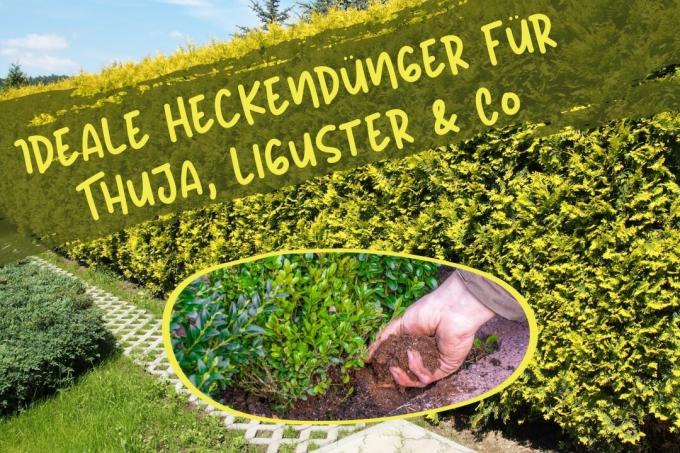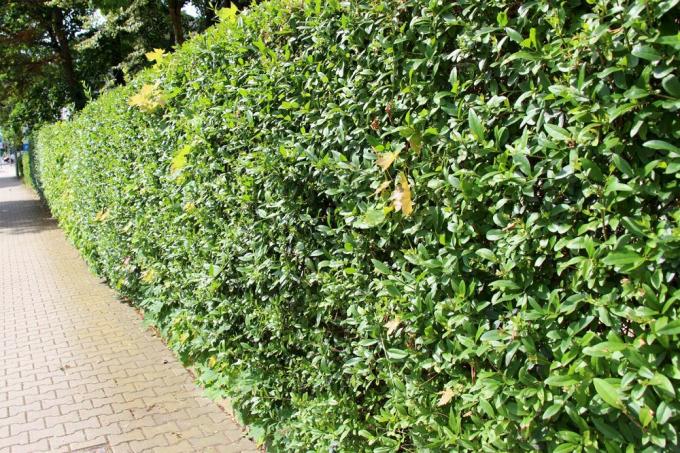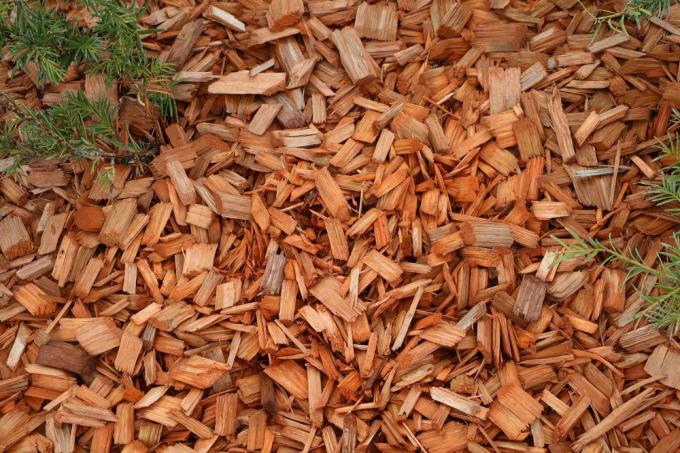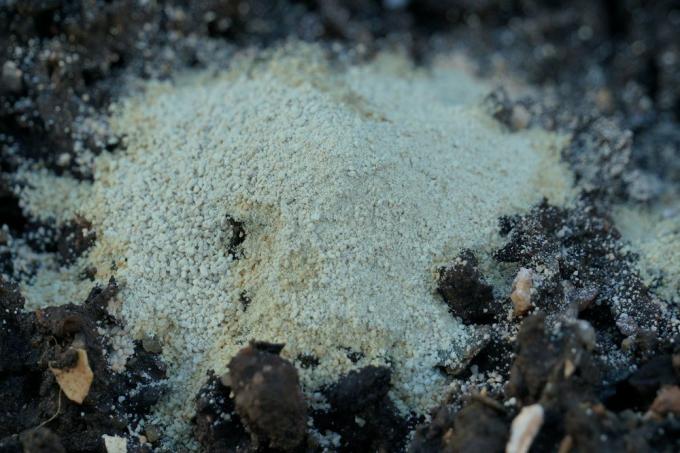
table of contents
- Supply of nutrients
- Which hedge fertilizer to use?
- Organic hedge fertilizer
- Mineral hedge fertilizers
- frequently asked Questions
Hedges are often used as a privacy screen from the prying eyes of the neighbors. In order for them to grow quickly and opaque, they need regular pruning and, of course, appropriate nutrients in the form of hedge fertilizer.
In a nutshell
- required ingredients are nitrogen, phosphorus and potassium
- fertilize organically with compost, horn shavings and co
- Use blue grain and Epsom salt as mineral fertilizers
Supply of nutrients
Not only regular pruning and watering are necessary for the growth of hedges, but also appropriate nutrients. Especially fast growing and evergreen Hedge plants have a very high nutritional requirement. Since hedge plants cannot absorb all nutrients from the soil, they must be administered in the form of hedge fertilizer, which contains the necessary ingredients. The composition of these fertilizers is important. The main components should always be nitrogen, phosphorus and potassium. They are known as so-called NPK fertilizers. Essential ingredients are therefore:
- Nitrogen for leaf growth, protein formation and chlorophyll production (leaf pigment)
- Phosphorus for seed and flower formation, for healthy growth and for energy transfer
- Potassium to regulate the water balance, increase resistance, protection against diseases, to strengthen the
Tissue - Magnesium as a central component of chlorophyll

In addition, various mineral trace elements such as boron, iron and cobalt are necessary for healthy growth. The nutrients are transported with the water into the pathways of the hedge plants and from there to the appropriate places.
Note: If the nutrients or nutrients are properly administered The necessary ingredients promote the growth of the hedge, which is particularly important for hedges that have not yet reached the desired height and width.
Which hedge fertilizer to use?
It is not only important to use the right time to fertilize, but also the type of fertilizer. The ingredients required must be taken into account. In other words, the hedge fertilizer must have the right mix of nutrients. It is also important how quickly these can be released and absorbed by the plants. According to the origin of the fertilizers, a distinction is made between:
Organic hedge fertilizer
This consists of plant and animal materials, mostly waste products from agriculture. After the fertilizer has been applied, it must first be broken down by microorganisms living in the soil before the necessary ingredients can be absorbed by the plants. These nutrients are gradually released over a longer period of time. A single fertilization in spring is sufficient. Alternatively, the fertilizer can also be applied in autumn. In the winter months the decomposition takes place and in the spring the nutrients are available to the plants. Over-fertilization with the hedge fertilizer is not possible. In addition, the soil fertility and the water retention capacity of the soil are improved and the formation of humus is increased.
Horn meal / horn shavings
- Manufacture from hooves and horns of slaughtered animals
- contain 85% organic substances
- main supply of phosphate and nitrogen
- Horn meal works faster
- Horn shavings better long-term effect
- Can be combined with mineral fertilizers

compost
- contain a high proportion of organic substances and nutrients
- good soil improver
- work lightly into the soil
- very suitable for boxwood, thuja and privet
Note: Compost as a hedge fertilizer changes the pH value of the soil. It becomes slightly alkaline. It is therefore not suitable for holly, rhododendrons and cypress trees.
Cattle and horse manure
- commercially available in pellet form
- Long-term effect up to six months
- activates soil life
- optimal supply of nutrients
- fresh manure must rot six months before use
Bark mulch & Co
- alternatively use of leaves and lawn clippings
- additional source of phosphate and magnesium
- Apply bark mulch 2 to 5 cm layer
- Grass clippings no higher than 2 cm

Note: When using bark mulch, work horn shavings into the soil beforehand, as the microorganisms remove nitrogen from the soil when the bark mulch decomposes.
Coffee grounds
- organic fertilizer substitute
- contains potassium, nitrogen and phosphorus
- lowers the pH value of the soil
- simply work into the soil
Mineral hedge fertilizers
These are industrially produced nutrient salts that are water-soluble. They are high in nitrate, phosphate, and potassium. The nutrients are available to the plants immediately after administration, but are only effective for a short time. The use is optimal in the presence of deficiency symptoms. However, over-fertilization of the plants is quickly possible here. The salts dissolve quickly in the soil, but should be used very sparingly. It is better to fertilize again during the growth phase if necessary. When using mineral fertilizers, you should also bear in mind that they wash out of the earth quickly and thus get into the groundwater. Preferred mineral hedge fertilizers are:
Blue grain
- so-called complete fertilizer
- sold under the name Nitrophoska
- contains all the nutrients necessary for growth
- quick care of the plants
- simply scatter and work lightly into the soil
- alternatively dissolve in water and pour
- dose sparingly
- rapid overdose possible
- not very environmentally friendly

Epsom salt
- correct name magnesium sulfate
- contains 16% magnesium and 13% sulfur
- Use specifically in case of magnesium deficiency
- effective immediately
- especially good for coniferous hedges
- easy to sprinkle
- then work it lightly into the soil
- alternatively add to the watering water
- Foliar fertilization is also possible, especially if there is a lack of magnesium
- to do this, dissolve salt in water
- Sprinkle leaves
- there direct nutrient uptake
Note: If the hedge fertilizer used does not contain Epsom salt or If it contains magnesium, you can also mix Epsom salt with the fertilizer.
Garden lime
By using it, the soil fertility, the water retention capacity and the air and heat circulation in the soil can be improved. In addition, the soil has a fine, crumbly structure, which improves the digestion of nutrients. It can be used all year round, but spring is ideal. Before you lime the soil, however, you should first use test sticks to check whether it is necessary to add lime. Instead of garden lime, crushed eggshells can also be easily worked into the upper layer of soil. These ensure a basic environment.

frequently asked Questions
In principle, fertilizers should always be applied during the growth phase, i.e. before the new shoots in March to August. This is where the need for nutrients is greatest. In autumn, fertilization should no longer be used, as the newly driven wood no longer matures and hardens by winter, and then major frost damage occurs.
Usually once a year is sufficient. However, it depends on the type of fertilizer. Mineral fertilizers dissolve very quickly and have no long-term effect. If necessary, it can be re-fertilized. On the other hand, fertilization with organic fertilizers in March is sufficient, as the effect lasts for a long time.
It depends on. When using container plants, it is not necessary as these are supplied with long-term fertilizers. On the other hand, bare-root plants can tolerate an application. Simply mix potting soil with ripe compost and horn shavings. Do not use mineral fertilizers. This can lead to root damage.
